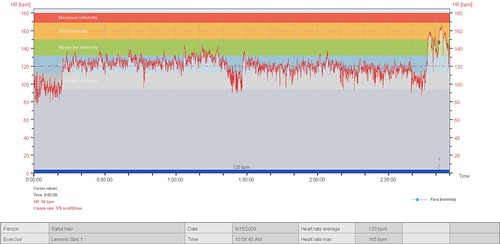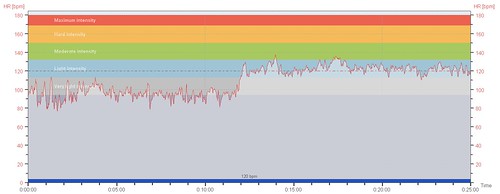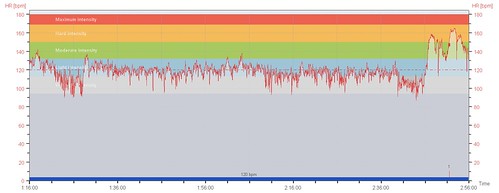Fatigue – that’s a word you hear being thrown about a lot at endurance racing events. We know that as drivers do long stints behind the wheel, fatigue starts setting in and the lap times start to drop steadily. But the $64,000 question is how long can a driver stay out on track without compromising the performance of his/her car or the safety of the other competitors. People keep throwing around the statistic of F1 drivers having an average heart rate of 170 bpm for the 90 odd minute duration of the race. That data might be useful for a young fit F1 driver who spends the entire duration of the race on the ragged edge, but is not very relevant to the average Lemons driver who is generally older, considerably less fit, often drives longer stints and (speaking for myself) is generally well under the limit.
In order to learn more about the physical demands of Lemons racing, I decided to wear a heart rate monitor during my driving stints behind the wheel of our #23 Pink Pig E30 at the 24 Hours of Lemons race at Buttonwillow this past August. Our friends at Chasecam lent us a PDR100 video kit and copy of their Dashware software that allowed me to sync my heartrate to both the video stream and the in-car telemetry collected using my Race Technologies DL1 data logger. The following is a summary of what I learned with some things being as expected and some things decidedly unexpected.
Current Fitness Level
I’ll start by giving a quick baseline values for my current fitness levels. I have a resting heart rate of just under 50 bpm and I run between 10-20 miles a week which puts me in the above average range of physical fitness. Click here to see an example heart rate trace from my last long run (outdoors, 85 F, 8.5 miles in 84 min, avg heart rate of 164 bpm).
Additionally since Buttonwillow in August is brutally hot (temps of 110 F are quite common) I did hot weather training (outdoor 10k twice a week at 2 in the afternoon) for a couple of months to help prepare for the heat stress. The temperatures during the race ended up being about 100F and I did wear a Cool Shirt which I used intermittently for the first hour and then continuously after that.
Data summary

The graph above shows my heart rate during a 2 hour 50 minute recording window. My average heart rate during this entire period was 120 beats/minute with a maximum of 165 bpm. As you can see there are several distinct segments where my heart rate varied significantly from the average. By syncing the heart rate data to the video I was able to find that each segment points to a specific event during the race.
Specific instances

Looking at the first 25 minutes of the data you can see that my heart rate initially hovers around the 90 bpm mark. At this time I was lined up in the pitlane and waiting for the cars to slowly get released onto the track. The small spike at the 4 minute mark happens exactly as I get out of the pits and onto the racing service. I should add that I had never driven a single lap of Buttonwillow before (mechanical issues on Friday) and was very nervous about going blind onto a new track. As I start doing the yellow flag laps you can see that my heart rate starts dropping again and stays that way for the next 7-8 minutes as I slowly learn my way around the track. The next spike you see is at the 12 minute mark and is shown in this short video below which has my heart rate in the top left corner.
As luck would have it the car right behind me was given the green flag which meant that I had zero warning of the race start. As the cars behind start passing me on the straight my heart rate starts rising from the low 90s and hits 129 bpm in the middle of turn 2.

The graph above shows the last 90 minutes of my stint. There is a gradual drop-off in my heart rate starting at about the 1:21 mark. This corresponds to a long full course yellow out on the track. The heart rate initially does not drop by much as I am staying close to car in front so that I can pass it at the next green flag, but as I drive further along the course I realize its a full course yellow and start relaxing which drop my heart rate to just over a 100. You can see another example of it in the video below which shows a yellow flag segment from my second stint on day 1.
The second dip you see towards the end of my day 1 stint happens when our car breaks down on the exit of turn 1 and I pull off the course and stop. While I’m initially quite agitated as I try to restart the car, I quickly realize that the car is dead and my heart rate starts dropping to the 100 bpm mark. About 5 minutes later the tow truck pulls up to the car and tows me back to the pits. Once I get there my heart rate once again starts rising and goes well past the 150 mark as I get out of the car to try and help fix the problem. It goes back down to the 140 mark as the problem is found and fixed but then rises to a peak of 165 as I am refueling the car (a 40 pound fuel can on your shoulder will do that).
As I went through the data, the most surprising fact for me was that the heart rate does not seem to have much correlation to the speed, g-force, laptime, etc… In fact it seems more psychological than it is physical. While there are some small changes over a lap, there are no significant bumps going through particular turns or even when passing individual cars. Instead the most pronounced changes in heart rate happen when you come up on a large group of cars and are unsure of how to pass them. The following video is a great example of this. Initially my heart rate is in the 115-120 bpm range as I go through the sweeper by myself. As I catch up to a group of five cars it rapidly rises and peaks at 144 bpm as I pass the last car. As soon as I pass them it starts dropping quickly and levels back down at the 120-125 bpm range.
For comparison here is a clean air lap where it drops as low as 97 bpm with a temporary spike at 131 bpm but spends the majority of the lap between 115 and 125 bpm
Summary
My stint in this case was for 2.5 hours in 100 degree weather and I could probably have driven for another hour. One thing to note is that I have plenty of experience driving on track (karting enduro, HPDE, Lemons) and can tell when my performance level goes down. If you are not familiar with driving on track and/or are driving at 10/10ths you will get mentally drained well before you get physically fatigued. If you dont take car to monitor your concentration you will start making more and more mistakes. The optimal stint length can and will vary dramatically even for the same person depending on their mental and physical state – I did a 4+ hour stint at Lemons Thunderhill 07 with no problems but when I drove a Spec Miata there I was wiped out in just 45 minutes.
In summary I can say that while Lemons is indeed quite strenuous, the mental aspect is more taxing than the physical. If you are used to good cardio workouts and can monitor your own concentration levels, it is possible to safely to do long stints. All this of course only applies to me and the way I drive – your mileage WILL vary and I make no statements about your driving abilities
Bonus video
And finally as bonus here is a 15 minute battle I had with the Itallion stallions Fiat X1/9. It starts off with them passing me on the run up to the hill and I then spend the next 15 minutes trying to get the position back. I’ve speeded up the sections where I am trying to catch up to them while the close quarters action is at regular speeds. Total run time is a little over 10 minutes. My favourite section is at the 6:20 mark where I pull alongside on the exit of the bus stop and we go side-by-side for 3 corners till I finally have to give up because they have the inside line over the hill. In case you are wondering they have modified the X1/9 to run motorcycle carbs which is why they were able to stay ahead on the straight. Plus this is within the first 10-12 laps on track so I’m still not very familiar with the track which I hope excuses the bad driving 🙂
One reply on “The physical demands of Lemons racing”
[…] mechanical expertise to solve any mechanical issues that may crop up. Having been to Buttonwillow once before, I knew that the heat would be brutal and was glad to pitch in with the other folks to share a […]